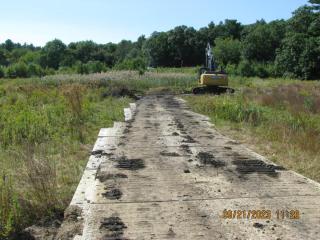What is happening at the cranberry bogs on South Main Street?

As you may have noticed, the cranberry bogs across from the Sharon Marketplace, between Old Post Road and Route 95, are undergoing some changes.
These bogs were originally part of the Sharon Gallery parcel and per the development agreement, are included in a 28-acre parcel that was deeded to the Conservation Commission as open space. For the next year or two, work will be ongoing there, including the removal of an invasive species and the planting of native vegetation in some of the cranberry beds.
Unfortunately, prior to the town taking possession of the land, the cranberry bogs had stopped being managed carefully enough to maintain the health of the cranberry vines to allow them to be harvested. Even with help from the developer to restore the cranberries, between the ongoing costs of maintaining the vines, managing weeds, clearing the ditches, importing sand for the beds and transporting the dry-harvesting equipment to and from the site, no farmers were interested in farming the cranberries. Reluctantly, the Conservation Commission decided that the next best use for the land would be to allow it to return to a natural wetland.
Many residents have expressed dismay at not only the state of the bogs, but also the fact that they will no longer be farmed. It may help to understand that these cranberry beds differ in a significant way from many others in the area. These bogs were always dry-picked, meaning that the cranberries were harvested from the beds without the beds being flooded first. This method requires different equipment from the wet-harvested beds like those on display at Patriot Place and throughout southeastern Massachusetts.
Rather than invest additional money in restoring bogs that no one was willing to farm, the Sharon Gallery developer will fund some major efforts to help return the area to a natural state.
This work includes the removal of several large patches of an invasive reed known as Phragmites. This plant, which has limited habitat value, threatened to completely colonize the site and exclude native species, including the remaining cranberries. The excavators you may have seen on site were working to remove this invasive plant.
In addition, some new planting beds that were never planted with cranberries have been spread with loam and will be seeded with native wetland plants. Cranberries are a native bog plant. They were likely present in the natural bog that is shown in this spot on a map from 1831, and with care they will persist indefinitely on this landscape.
While the site and surrounding areas are under construction, for the safety of the public, the Conservation Department will not be encouraging visits to this site.
See more photos of the site attached below.
Please join us in watching from nearby as this area returns to a natural state. We look forward to promoting its use for passive recreation in the years to come.